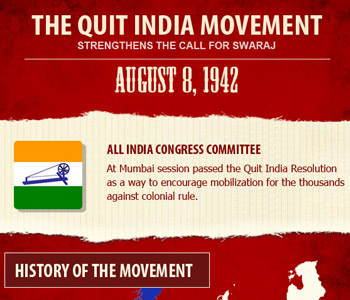Click to view full Infographic In the first of many battles between the British colonial government and those looking for an independent Indian state, the Quit India Movement came to prominence on August 8, 1942 in the shadow of the Second World War. Answering the call for peaceful protest in order to demonstrate the need for what Mohandas Gandhi had called “an orderly British withdrawal” earlier in the day at Gowalia Tank Maidan, the Bombay session of the All India Congress Committee passed the Quit India Resolution as a way to encourage mobilization of the thousands who supported the end of colonial rule. The history of the movement went back almost three years. After the British committed to the fight against Adolf Hitler and Benito Mussolini in Europe, the Congress Party in India offered support on the condition that independence would be granted. The British Governor-General, John Hope, Lord Linlithgow, turned the request aside and brought the colony into the conflict anyway. (Gandhi felt conflicted about the issue, hoping as always to avoid violent action, but feeling the racist propaganda and extermination policies of the Axis Powers had to be stopped.) On the other hand, some groups threw their full backing into the fight, with The Muslim League declaring its support immediately. Led by Netaji Subhas Chandra Bose, others worked to organize an Indian National Army to get help from Japan in subverting British rule through guerilla warfare. With the war effort faltering in Europe, the crown sent a delegation to India led by Stafford Cripps to offer increased autonomy to the Indian National Congress in March 1942. Without a concrete timetable for the assumption of complete rule, the Indian representatives balked at Cripps’ proposal and left the negotiating table. In mid-July, the Congress Working Committee pushed through a draft requiring the British to move out and allow India to self-govern, including within the sections, a call for civil disobedience if the resolution was ignored. Despite conflicting opinions – some within the Congress hoped to bring The Muslim League into agreement in order to provide a united front – the movement gained steam. So it was that the Quit India Resolution passed in Bombay on August 8, 1942. Gandhi called for resolve among the people, for them to take up a peaceful protest determined to see an independent India shine through – “Do or Die,” he said. Even with a staggering number of Indians willing to engage in civil disobedience, the Communist Party of India and Muslim League continued to stand against nationalism. The British, for their part, would not stand for such outward displays of insubordination – especially with the Japanese nearing the border with Burma. The following morning, tens of thousands of arrests were made, effectively imprisoning many in the Quit India Movement the day after it had begun. Demonstrators continued to protest without any true leadership, generally remaining respectful knowing fines and public floggings may result. With many of the Congress in jail and political opposition like the Muslim League using the situation to capitalize, the call for swaraj – “home rule” – went underground for the better part of three years. Though the Quit India Movement would never quite be successful, India would gain independence from Britain on August 15, 1947, a little more than five years after Gandhi’s infamous speech.
August 8, 1942 CE – The Quit India Movement Strengthens the Call for Swaraj
Click to view full Infographic In the first of many battles between the British colonial government and those looking for an independent Indian state, the Quit India Movement came to…
